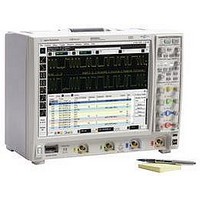DSO9104A AGILENT TECHNOLOGIES, DSO9104A Datasheet - Page 22

DSO9104A
Manufacturer Part Number
DSO9104A
Description
OSCILLOSCOPE, 1GHZ, 4 CHANNEL, 20GSPS
Manufacturer
AGILENT TECHNOLOGIES
Datasheet
1.N2902A.pdf
(28 pages)
Specifications of DSO9104A
Scope Type
Digital
Scope Channels
4 Analog
Bandwidth
1GHz
Meter Display Type
XGA TFT-LCD Color
Sampling Rate
20GSPS
Input Impedance
1Mohm
Rise Time
253ps
Input Voltage
150Vrms
Lead Free Status / RoHS Status
na
Infi niium 9000 Series performance characteristics
22
Trigger modes
Edge (analog and digital)
Edge transition (analog)
Edge then edge (time)
(analog and digital)
Edge then edge (event)
(analog and digital)
Glitch (analog and digital)
Line
Pulse width (analog and digital)
Runt (analog)
Timeout (analog and digital)
Pattern/pulse range
(analog and digital)
State (analog and digital)
Setup/hold (analog)
Window (analog)
Video (analog)
Serial (analog and digital)
Zone-qualified
4 GHz model
2.5 GHz model
1 GHz and 600 MHz model
Triggers on a specified slope (rising, falling or alternating between rising and falling) and voltage
level on any channel.
Trigger on rising or falling edges that cross two voltage levels in > or < the amount of time specified.
Edge transition setting from 250 ps.
The trigger is qualified by an edge. After a specified time delay between 10 ns to 10 s, a rising or
falling edge on any one selected input will generate the trigger.
The trigger is qualified by an edge. After a specified delay between 1 to 16,000,000 rising or falling
edges, another rising or falling edge on any one selected input will generate the trigger.
Triggers on glitches narrower than the other pulses in your waveform by specifying a width less than
your narrowest pulse and a polarity. Glitch range settings equal pulse width settings
Triggers on the line voltage powering the oscilloscope.
Trigger on a pulse that is wider or narrower than specified.
Minimum detectable pulse width: 125 ps for analog channels, 1 ns for digital channels.
Pulse width range settings: 250 ps to 10 s for analog channels, 2 ns to 10 s for digital channels.
Minimum detectable pulse width: 200 ps for analog channels, 1 ns for digital channels. Pulse width
range settings: 350 ps to 10 s for analog channels, 2 ns to 10 s for digital channels.
Minimum detectable pulse width: 500 ps for analog channels, 1 ns for digital channels. Pulse width
range settings: 700 ps to 10 s for analog channels, 2 ns to 10 s for digital channels.
Triggers on a pulse that crosses one threshold but fails to cross a second threshold before crossing
the first again. Runt settings equal pulse width settings.
Trigger when a channel stays high, low, or unchanged for too long.
Timeout settings equal pulse width settings.
Triggers when a specified logical combination of the channels is entered, exited, present for a
specified period of time or is within a specified time range or times out. Each channel can have a
value of High (H), Low (L) or Don’t care (X).
Pattern trigger clocked by the rising, falling or alternating between rising and falling edge of one channel.
Triggers on setup, hold, or setup and hold violations in your circuit. Requires a clock and data signal
on any two inputs (except aux or line) channels as trigger sources. Setup and/or hold time must
then be specified.
Trigger on entering, exiting, or inside specified voltage range
NTSC, PAL-M(525/60), PAL, SECAM(625,50) EDTV(480p/60), EDTV(576/50), HDTV(720p/60),
HDTV(720p/50) HDTV(1080i/60)
Requires specified serial software option, I
PCIe, MIPI D-Phy, generic 8B/10B
Requires InfiniiScan software option. SW-based triggering across up to 8 user-drawn zones. For each
zone, user specifies “must intersect” or “must not intersect.” Zones can be drawn on multiple
channels and combined using Boolean expressions.
2
C, SPI, CAN, LIN,FlexRay, RS-232/UART, JTAG, USB,








